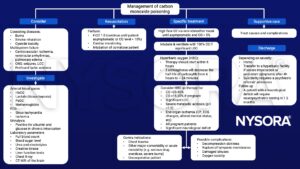Learning objectives
- Diagnose and treat carbon monoxide (CO) poisoning
Definition and mechanisms
- Carbon monoxide is a colorless, odorless, tasteless gas produced by burning gasoline, wood, propane, charcoal, or other fuel
- volatile anesthetics can produce CO when used with CO2 absorbents
- CO intoxication causes tissue hypoxia in three ways:
- CO binds with hemoglobin with about 250 times the affinity of oxygen, therefore, preventing oxygen binding
- CO also leads to a shift in the oxygen dissociation curve to the left impending delivery
- CO competitively inhibits the binding of oxygen with cytochrome oxidase, a key mitochondrial enzyme, significantly impairing cellular utilization of oxygen
- Mortality is 1-3%
Signs and symptoms
| Acute poisoning | |
| Central nervous system | Headache Dizziness Confusion Altered mental status Incoordination Ataxia Seizures Coma |
| Cardiovascular system | Dysrhythmias Ischemia Hypertension Hypotension |
| Gastrointestinal tract | Abdominal pain Nausea Vomitting Diarrhea |
| Respiratory system | Dyspnea Tachypnea Chest pain Palpitation |
| Other | Non-cardiogenic pulmonary edema Lactic acidosis Rhabdomyolysis Hyperglycemia Disseminated Intravascular Coagulation (DIC) Bullae Alopecia Sweat gland necrosis |
| Chronic exposure | |
| May have similar effects to acute poisoning, but often with a gradual, insidious onset, and symptoms may fluctuate with varying levels of exposure to CO over time | Headache Personality changes Poor concentration Dementia Psychosis Parkinson’s disease Ataxia Peripheral neuropathy Hearing loss |
Complications
- Chronic fatigue
- Permanent brain damage
- Damage to your heart, possibly leading to life-threatening cardiac complications
- Fetal death or miscarriage
- Death
Diagnosis
- Standard SpO2 does not identify CO poisoning
- HbCO level of more than 3% among nonsmokers and more than 10% among smokers
- ECG indication of ischemia
- Clinically significant acidosis
Management

Suggested reading
- Chenoweth JA, Albertson TE, Greer MR. Carbon Monoxide Poisoning. Crit Care Clin. 2021;37(3):657-672.
- Horncastle, E., Lumb, A.B., 2019. Hyperoxia in anaesthesia and intensive care. BJA Education 19, 176–182.
- Gill, P., Martin, R.V., 2015. Smoke inhalation injury. BJA Education 15, 143–148.
We would love to hear from you. If you should detect any errors, email us customerservice@nysora.com


